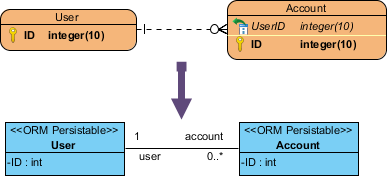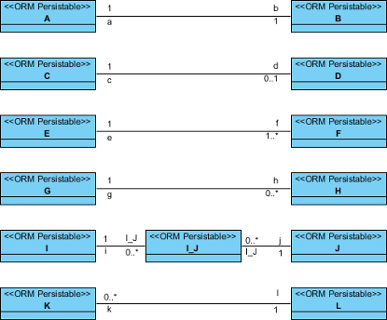Visual Paradigm supports Object Relational Mapping (ORM) which maps data model to object model and vice versa. Visual Paradigm helps mapping entities to classes. Source files can then be generated from classes for use in software development. The mapping to object model preserves the data, but also the state, foreign/primary key mapping, difference in data type and business logic. Thus, you are not required to handle those tedious tasks during software development.
Mapping entities to classes
All entities map one-to-one to persistent classes in an object model. Classes that map with entities are represented by the stereotype <<ORM Persistable>>.

In the above example, the Customer entity map one-to-one the Customer class as the Customer instance can store the customer information from the Customer Entity.
Mapping columns to attributes
Since all entities map one-to-one to persistent classes in an object model, columns in turn map to attributes in a one-to-one mapping. Visual Paradigm ignores all specialty columns such as computed columns and foreign key columns.

Mapping data type
Column types are automatically mapped to appropriate attribute types. The following table lists out the typical mapping between data model and object model.
| Data Model | Object Model |
|---|---|
| bigint | Long |
| binary | Byte [] |
| bit | Boolean |
| blob | Blob |
| varchar | String |
| char | Character |
| char (1) | Character |
| clob | String |
| date | Date |
| decimal | BigDecimal |
| double | Double |
| float | Float |
| integer | Integer |
| numeric | BigDecimal |
| real | Float |
| time | Time |
| timestamp | Timestamp |
| tinyint | Byte |
| smallint | Short |
| varbinary | Byte [] |
Mapping primary key
As the columns map to attributes in a one-to-one mapping, primary key columns in the entity map to attributes as a part of a class.

In the example, the primary key of entity Product, ProductID maps to an attribute ProductID of the class Product.
Mapping relationship
Relationship represents the correlation among entities. Each entity of a relationship has a role, called Phrase describing how the entity acts in it. The phrase is attached at the end of a relationship connection line. Visual Paradigm maps the phrase to role name of association in the object model.
Mapping cardinality
Cardinality refers to the number of possible instances of an entity relate to one instance of another entity. The following table shows the syntax to express the Cardinality.
| Type of cardinality | Description |
|---|---|
| Zero or one intance | |
| Zero or more instances | |
| Exactly one instance | |
| One or more instances |

In the above example, it shows that a user contains multiple accounts.
Mapping many-to-many relationship
For each many-to-many relationship between entities, Visual Paradigm generates a link entity to form two one-to-many relationships in between. The primary keys of the two entities will automatically migrate to the link entity to form the primary/foreign keys.

In the above example, Visual Paradigm generates the link entity once a many-to-many relationship is setup between two entities. To transform the many-to-many relationship, Visual Paradigm maps the many-to-many relationship to many-to-many association.
Mapping Array Table to collection of objects
Visual Paradigm promotes the use of Array Table to allow users retrieve objects in the form of primitive array.
When Visual Paradigm transforms an array table, the array table will map to an attribute with array type modifier.

In the above example, each Contact may have more than one phone numbers, stored in ContactEntry_Phone. The array table of ContactEntry_Phone maps into the phone attribute with array type modifier in the ContactEntry class.
Typical mapping between data model and object model
| Object Model | Data Model |
|---|---|
 |
 |